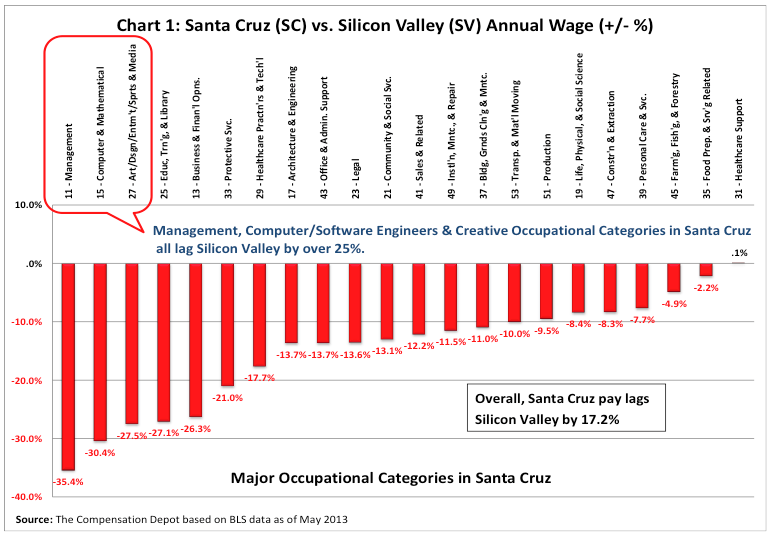Santa Cruz Real Estate
Digest,
Ed. 22
|
|
|
|
|
|
June, 2017 - In This Issue:
|
|
|
|
|
|
In This Month's Issue
|
|
We are just emerging from a six year drought, and with man-made climate change on the horizon it's important to ask, where does our water come
from
and is it sustainable? Read below to find out.
As we talk to clients, we are hearing a similar tune: Will housing prices ever go down? Read our thoughts on this topic below.
Are you renting out an unpermitted space? Are you interesting in buying a home with an unpermitted space and hoping to rent it out? Then don't miss Christine's Corner!
|
|

Real Estate Market Statistics
For Santa Cruz, Santa Clara, and
Monterey
The reports contain median home prices, real estate price statistics, valuable information about mortgage rates and much more.
|
Without access to water, a property
essentially
has no value. We are just emerging from a six year drought, and with man-made climate change on the horizon it's important to ask, where does our water come from and is it sustainable?
As a resident of Santa Cruz County, your water comes from:
-
5 larger water suppliers
-
4 smaller systems
-
130 small systems
-
8,000 private wells
And you are part of one of the following water districts:
Nearly all of Santa Cruz County's water supply is locally derived from surface (streams and reservoirs - 20% of supply) and groundwater sources (80% of supply). This is beneficial because Santa Cruz often has more control over rationing and water management in times of drought than those Counties that rely on State and Federal water programs.
Santa Cruz still faces major challenges in managing its groundwater supply; annually we are extracting more water from the ground than is being naturally replenished. Additionally, climate change is projected to reduce supply by 30% by 2100. Due to climate change, researchers expect an increase in irrigation demand, longer and more extreme droughts, a reduction in rainfall, and higher temperatures.
Santa Cruz is not the only county facing persistent water issues. As the result, Governor Jerry Brown signed the Sustainable Groundwater Management Act (SGMA) into law on January 1, 2015. Under the SGMA, local agencies must form groundwater sustainability agencies (GSAs) by 2017 and create groundwater sustainability plans (GSPs) for high and medium priority basins by 2020 or 2022. The following GSA's have been formed here in Santa Cruz:
These agencies have the following powers under SGMA:
-
Adopt rules, regulations, ordinances and resolutions
-
Investigate water rights
-
Require well registration, extraction reports, and storage diversions
-
Acquire property and water rights
-
Reclaim water
-
Impose fees
-
Conduct enforcement actions for failure to comply
With the ability to enforce eminent domain (taking one's property with fair compensation), these GSA's are not to be overlooked. A representative of the Santa Cruz Mid-County Agency stated that the agency would rather work with the community than enforce such laws during a talk given to Realtors at the Santa Cruz County Assocation of Realtors. The Santa Cruz Mid-County Agency is
actively looking for members
for its Groundwater Sustainability Plan (GSP) Advisory Committee and the Santa Margarita Groundwater Agency meetings are open to the public
. Playing an active role in these kinds of committees and meetings is one way to proactively protect your water rights while helping our community find sustainable water-management solutions.
For additional information, see the sources below:
http://scceh.com/Home/Programs/WaterResources/GroundwaterManagement.aspx
|
Will Prices Ever Go Down? Long Term Trends
As we talk to clients, we are hearing a similar tune: Will housing prices ever go down?
There are many theories about the cyclic nature of real estate, and how housing prices will behave. While only time will tell which are true, we can look at some of the data on housing prices here in Santa Cruz to gain a better understanding of the long term trends.
First, let's take a look at the 10+ year trend in Santa Cruz and in the US from 1996 to 2017:
One interesting observation is that while national median home prices rose by close to $120,000 or 85% from 1996 up to the recession, median housing prices in Santa Cruz County shot up over $500,000, or 250% before falling. Was there more speculation in our local market? Possibly, though a growing economy in the Silicon Valley and the willingness of an older generation of affluent buyers to pay a premium for the Santa Cruz lifestyle may explain the increase in prices. The crux of Silicon Valley's growth occurred throughout the mid- and late-1900's and continues to this day. Some part of the steady rise in housing prices reflected in the data leading up to the crisis may be due to these economic developments. If strong economic growth locally and in our neighboring cities can account for these elevated home prices, than we don't expect a dramatic downturn anytime soon.
It's very noticeable that housing prices in both the US and Santa Cruz have risen above their pre-crisis peak levels. Does this signal another housing bubble? In this
post
, economists at Freddie Mac say we don't have reason to be worried, yet. They analyze "hot-spots" across the country using the Price-to-Income (PTI) ratio, which is found by dividing the median price of recently sold homes by median household income. When this ratio is higher than "normal" (3.5-4.1 is typically considered the safe zone), this suggests that housing is taking up an unsustainably large proportion of household budgets. It may also signal that home buyers are expecting housing prices to increase at a rapid pace. When prices rise because of homebuyers
expectations
rather than for economic reasons, such as growth in the economy, then it is more likely that we are in bubble territory.
When analyzing areas around the country with higher than normal PTI's, economist at Fannie Mae seek to cite economic reasons for such growth. If they cannot do so, this suggests a bubble may ensue. For example, San Jose is one such hotspot with a PTI of 9.6. Economist are not worried about this high ratio because San Jose has a higher threshold for high PTI's due to the fact that it contains much of the Silicon Valley and the tech-sector is typically more volatile. Housing prices will rise when tech is doing well and fall when there is a downturn in the tech industry.
What about Santa Cruz? Here is a chart of the Santa Cruz PTI over the past 20+ years:
Click
here
for an interactive version of this chart (use the drop down menu to select Santa Cruz).
The only county in California with a higher PTI than Santa Cruz is San Francisco. Why? Economist at Fannie Mae point out that PTI's in San Francisco are much higher than the national average because of its desirable location and low availability of space for new construction. Santa Cruz is one of the most beautiful places on earth and people are clearly willing to pay a premium for the high quality of life that Santa Cruz provides. Additionally, in this article
, CEO of the Santa Cruz Chamber of Commerce, Bill Tysseling points out th
at
it is challenging to develop new property in Santa Cruz. This perpetuates a low inventory.
With that said, how high of a premium is sustainable with our present-day local income levels? Santa Cruz currently has a slightly higher PTI than the peak preceding the Great Recession (12.67 in present day vs. 12.39 then), though economic analysis is needed to draw a parallel between the two.
What is clear is that housing affordability for Santa Cruz locals is low. The affordability index in Santa Cruz was 17 in Q1 of 2017, meaning only 17% of households could afford to buy a home at the current median home price. This suggests that the continued increase in housing prices may be explained by an influx of new, higher income residents from the Silicon Valley.

Tysseling points out that we don't imagine our county as one dominated by "high-wage out-commuters, the wealthy retired, owners of second homes and vacationers", rather as an independent economy where families live and work, and young adults can create vibrant and meaningful careers. Even if our current housing prices are fueled by economic growth in the Silicon Valley, many residents can agree that we'd rather see a rise in prices due to local economic activity. We hear the frustration of locals who are unable to afford a home for their families. Tysseling calls for
reallocation of public funding towards investing in neighborhoods, transportation and schools; growing jobs; and housing development. Doing our part to support these initiatives will help make our community healthier, and keep housing price at a sustainable level for local residents. There has been work done towards this goal, with initiatives
such as the
Santa Cruz Economic Development
project and plans to increase density through rezoning (i.e.
Santa Cruz Corridor Zoning changes)
.
And so, it's true that prices are higher than they have ever been. We appear to be experiencing a shift in income levels in our surrounding regions rather than a housing bubble, and we don't expect a dramatic downturn anytime soon. If housing inventory increases in the San Jose area, issues such as long commute times and road problems (this winter we experienced quite a few) could slow down this influx, and as a result, we may see a gradual decline in housing prices.
Regardless of what happens in our neighboring cities, we believe that the hard work and determination of Santa Cruz Residents will maintain healthy growth in housing prices.
|
Christine's Corner

Are you renting out an unpermitted space? Are you interesting in buying a home with an unpermitted space and hoping to rent it out? Then please read on.
Anyone who has been around real estate in Santa Cruz for a while knows that renting illegal units is a common practice. However, there is a bigger potential issue with renting out an unpermitted space that many people may not know. This issue is that the tenant may not be required to pay rent in case of an eviction or legal disagreement.
In 2009, a
court ruling
set the following precedent. A tenant was evicted by a landlord after failing to pay three months' rent. The tenants had raised various claims about the substandard conditions of the unit, including that it had not been certified for occupancy. The court referred to the fact that the Santa Ana municipal code prohibits the use or occupation of a building "until the building official has issued a certificate of occupancy". In this particular case, no occupancy permit had been issued therefore the court held that "the occupancy was unlawful and the lease constitutes an illegal contract." The ruling handed down was that the tenant had no obligation to pay the rent due to the illegality of the unit.
This means that, at the discretion of a judge, renting out an illegal unit could be costly should you and your tenant fall into a disagreement. I am well aware that the process of gaining the required permits can be costly and take up precious time, but it's important to understand the risks involved in renting out an illegal unit and to weigh your options carefully.
|
|
|
|
|